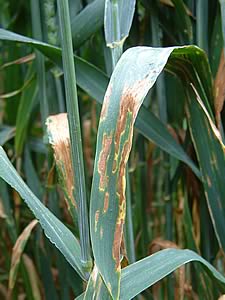 |
|||||||||
|
|||||||||||||||||||
|
|
Crucial Year for Rust and Septoria Wheat Flag Leaf Protection 2010-05-17 Variety susceptibility coupled with showery weather look set to make this a crucial year for maintaining robust protection of wheat flag leaves against rusts with strobilurin fungicides and Septoria with chlorothalonil, says Syngenta technical manager Chris Rowsell. It’s a strategy that’s underlined by results from a Syngenta poll conducted earlier this season, he notes.
According to Mr Rowsell, around four fifths of the certified wheat seed sown this season could be susceptible to either yellow rust, brown rust or both with variety resistance ratings of six or below. Added to that, recent rains will have encouraged the rain-splash spread of Septoria spores onto higher leaves. So with Septoria tritici having reduced yield up to 4 t/ha in trials, yellow rust up to 6 t/ha and brown rust up to 3 t/ha, protecting flag leaves - which contribute almost 45% to wheat yield - against all three threats could be crucial to profitability, he stresses. “Including a suitable strobilurin with the flag leaf spray at T2 will give more robust protection against rusts than using a triazole alone,” explains Mr Rowsell, “because it targets different stages of the rust life cycle. “The strobilurin Amistar for example targets spore germination, the early stages of spore invasion of the leaf surface and spore production, while a triazole is more effective at stopping the fungus spreading within the plant.
“And in a poll of cereal disease experts we conducted earlier this season, 70% felt it would be more important to include a rust-active strobilurin at T2 this season compared with previous years,” he points out. With Septoria risks heightened after recent rainfall, Mr Rowsell says chlorothalonil inclusion will also have an important role at this year’s T2 spray timings - not least with the need to protect triazole chemistry against the threat of Septoria tritici resistance. “In our same poll of disease experts, 10 out of 10 respondents rated the inclusion of chlorothalonil in programmes as either useful or extremely useful at protecting triazoles, with 8 out of 10 rating T2 as an important timing to include it. “At a practical level, rather than adding strobilurin and chlorothalonil separately to the spray tank, the co-formulation of Amistar Opti provides the components of Amistar and chlorothalonil in a single pack. That saves time and is actually a more cost-effective option. “It has also given superior spray retention to an Amistar + chlorothalonil tank mix in testing, as well as a yield advantage over the same tank mix in the majority of cases. “In our poll, 100% of respondents believed Amistar Opti had either a useful or extremely useful role in helping growers cost-effectively respond to yellow rust and Septoria tritici threats at T2.”
|
||||||||||||||||||

|
|
||||||||||||||||||
| home | agri-services | pedigree
pen | news | dairy | beef | machinery property | organisations | site map |
|||||||||||||||||||



